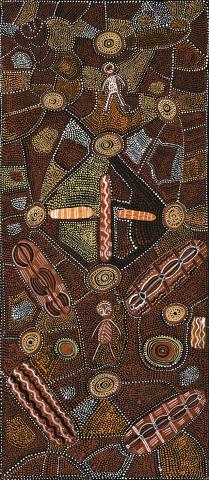UNTITLED (MEDICINE AND BUSH TUCKER), 1972
MICK NAMARARI TJAPALTJARRI
synthetic polymer powder paint on composition board
65.0 x 29.0 cm
signed verso: mick
Executed in the painting shed at Papunya, Northern Territory
Private collection (the father of a teacher working at Papunya), acquired in 1972
Sotheby's, Melbourne, 29 June 1998, lot 217
Private collection, Tasmania
For a discussion of the Fire, Spirit, Myth and Medicine Dreamings theme see Bardon, G., and Bardon, J., Papunya, A Place Made After the Story: The Beginnings of the Western Desert Painting Movement, The Miegunyah Press, Melbourne, 2004, pp. 51–52 and for an outline of the Bush Tucker stories see ibid., pp. 52–53. For another work by the artist executed in 1972 depicting a similar themed Medicine Story see ibid., p. 294 (painting 235)
Undoubtedly one of the most important founding figures of the Papunya Tula movement, Mick Namarari Tjapaltjarri quietly revolutionized the genre over his 30 year career. As noted by Dick Kimber in his obituary to the artist in 1998, the remarkable breadth and virtuosity of Mick Namarari's practice may be grounded in the significant number of sites for which he was responsible. Along with fellow Pintupi painting veteran Yala Yala Gibbs Tjungurrayi, the work of Mick Namarari from the 1990s, whilst issuing from the work of the early 1970s, demonstrates a dynamism that mark them as contemporary practice. The breadth and scope of his ability, maintained with singular dedication is such that his work is considered to have 'transformed Papunya Tula art, heralding the ethereal minimalism of the late 1980s and 1990s' Up until he passed away in 1998, Mick Namarari was still quietly revolutionising the genre.'1
Mick Namarari's works are loaded with symbolism which is closely tied to narrative, a dense and tightly coded abstraction which elegantly refers to his key stories in ever greater loops. Western Desert painting operates in the space between ceremony and country, referencing each whilst exploring ancestral inheritance. Namarari developed a visual language which was bound by cultural protocol but never restrained by it.
The artist was born in sandhill country at Marnpi Rockhole located south-west of the Mount Rennie Bore. After the death of both his parents Tjapaltajarri and his sister were looked after by other members of the family. Namarari attended school at the Hermannsburg mission until he was eleven years old, and was initiated in the Areyonga region, eventually working in the cattle industry. He adopted the middle name 'Namarari' after his employer MacNamara, though it also expressed similarities to one of Namarari's totems, the mallee fowl.
This work, dated from the second year of the Papunya painting movement, is executed on composition board. A year earlier, Namarari, under the encouragement of Geoffrey Bardon, had begun painting his designs on discarded pieces of composition board with other at Papunya. The painting is a gracefully controlled and highly detailed composition. Two figures together with ceremonial (medicine) objects float over a dense pointillist field of multi-coloured dotting. Symbolising the journeys of ancestral men and women whose acts may only be known by a select few, while at the same time illustrating a landscape of country depicting water courses, vegetation and birdlife.
1. Perkins, H., and Fink, H., 'Genesis and Genius: The Art of Papunya Tula Artists', in , Art Gallery of New South Wales, Sydney, 2007, p. 184
